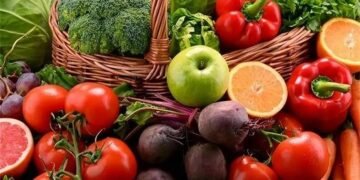Dinner, as the last meal of the day, is not only crucial for maintaining energy levels, but also directly affects sleep quality and mental state the next day. Scientific and reasonable dinner choices can help us achieve a comprehensive healthy lifestyle, including balanced diet, nutritional supplementation, weight management, and disease prevention. This article will explore how to achieve these goals by choosing whole foods, organic ingredients, and plant-based foods. We will provide a healthy diet guide, in-depth analysis of nutritious foods, the latest research in nutrition, and food safety information, and share several dinner recipes that can help improve energy and vitality. Finally, we will provide a guide from the field to the dining table to help readers make more environmentally friendly and healthy food choices.
The contribution of a healthy lifestyle
1. Balanced diet: Dinner should contain sufficient protein, complex carbohydrates, healthy fats, fiber, vitamins, and minerals to meet the body’s needs. For example, whole grains, beans, nuts, seeds, vegetables, and fruits are all important sources of food.
2. Nutritional Supplements: Some superfoods are rich in specific nutrients such as Omega-3 fatty acids, vitamin C, and iron, which can compensate for deficiencies in daily diet. For example, chia seeds are rich in Omega-3 fatty acids, which are beneficial for heart health.
3. Weight Management: Choosing low calorie, high fiber foods for dinner can help control weight and improve metabolic health. For example, oats are rich in beta glucan, which helps to lower cholesterol and blood sugar levels.
4. Disease prevention: Antioxidants and anti-inflammatory ingredients in dinner can reduce the risk of chronic diseases, such as cardiovascular disease, type 2 diabetes and some cancers. For example, anthocyanins in blueberries have strong antioxidant properties.
Healthy Eating Guide
1. Choose whole foods: Whole foods refer to unprocessed or minimally processed foods such as whole grains, beans, nuts, seeds, vegetables, and fruits. These foods retain more nutrients and fiber, which helps maintain health.
2. Organic Ingredients: Prioritize organic certified ingredients to ensure they are free of chemical pesticides and fertilizer residues, making them safer and healthier. Organic agriculture follows natural laws and helps protect the environment.
3. Plant based foods: Plant based foods are rich in fiber, vitamins, minerals, and antioxidants, which help improve energy and vitality and prevent diseases. For example, kale, beetroot, and quinoa are all high-quality plant-based ingredients.
4. Seasonal Ingredients: Choosing organic ingredients of the season not only offers more affordable prices but also higher nutritional value. Understand the seasonal ingredients of different seasons and develop corresponding recipes. For example, strawberries, spinach, and asparagus can be chosen in spring, while summer is the harvest season for tomatoes, cucumbers, and watermelons.
Healthy dinner recipe sharing
1. Quinoa vegetable Fried Rice
Ingredients: 1 cup of organic quinoa, 1 organic red pepper, 1 organic carrot, 1 organic broccoli, 1 organic onion, 2 cloves of organic garlic, 2 tablespoons of organic olive oil, 1 teaspoon of soy sauce, 1 teaspoon of ginger, 1/4 cup of organic peas, a little salt and black pepper
Preparation method: Boil the quinoa until cooked and set aside for later use. Cut red peppers, carrots, broccoli, and onions into cubes, and slice garlic. Heat olive oil in a pot, add garlic and onions and stir fry until fragrant, then add other vegetables and stir fry for a few minutes. Add quinoa, soy sauce, ginger, peas, salt, and black pepper, and continue stir frying until evenly mixed.
2. Stewed tofu with beetroot and broccoli
Ingredients: 1 organic beetroot, 1 organic broccoli, 1 organic tofu, 1 organic onion, 2 cloves of organic garlic, 2 tablespoons of organic olive oil, 1 teaspoon of ginger, 1 teaspoon of curry powder, 1 cup of organic vegetable broth, 1/4 cup of organic coconut milk, a little salt and black pepper
-Method of making: Cut beetroot and broccoli into pieces, diced tofu, chopped onions and garlic. Heat olive oil in a pot, add onions and garlic and stir fry until fragrant, then add ginger and curry powder and stir fry. Add beetroot and broccoli, stir fry for a few minutes. Pour in vegetable broth and coconut milk, add tofu, bring to a boil over high heat, then simmer over low heat for 15 minutes until the vegetables become soft. Season with salt and black pepper, ready to eat.
3. Mushroom quinoa stew
Ingredients: 1 cup of organic quinoa, 1 cup of organic mushrooms, 1 organic carrot, 1 organic onion, 2 cloves of organic garlic, 2 tablespoons of organic olive oil, 1 teaspoon of rosemary, 1 teaspoon of thyme, 1 cup of organic vegetable broth, 1/4 cup of organic tomato sauce, a little salt and black pepper
Preparation method: Boil the quinoa until cooked and set aside for later use. Sliced mushrooms, diced carrots, chopped onions and garlic. Heat olive oil in a pot, add onions and garlic and stir fry until fragrant, then add rosemary and thyme and stir fry. Add mushrooms and carrots, stir fry for a few minutes. Pour in vegetable broth and tomato sauce, add quinoa, bring to a boil over high heat, then simmer over low heat for 15 minutes until the vegetables become soft. Season with salt and black pepper, ready to eat.
4. Lentil tomato stew
Ingredients: 1 cup of organic beans, 1 organic onion, 1 organic red pepper, 1 organic tomato, 2 cloves of organic garlic, 2 tablespoons of organic olive oil, 1 teaspoon of chili powder, 1 teaspoon of smoked chili powder, 1 cup of organic vegetable broth, 1/4 cup of organic tomato sauce, a little salt and black pepper
Preparation method: Soak the beans in advance for 4 hours, cook them and set aside. Cut onions, red peppers, and tomatoes into cubes, and slice garlic. Heat olive oil in a pot, add onions and garlic and stir fry until fragrant, then add chili powder and smoked chili powder and stir fry. Add red peppers and tomatoes, stir fry for a few minutes. Pour in vegetable broth and tomato sauce, add the beans, bring to a boil over high heat, then simmer over low heat for 20 minutes until the beans become soft. Season with salt and black pepper, ready to eat.
A guide from the fields to the dining table
1. Choose organic ingredients: Prioritize organic certified ingredients to ensure they are free of chemical pesticides and fertilizer residues, making them safer and healthier. Organic agriculture follows natural laws and helps protect the environment.
2. Local procurement: Purchase locally produced organic ingredients that are not only fresh, but also reduce carbon emissions during transportation, supporting local agriculture. By participating in local farmers’ markets or joining Community Supported Agriculture (CSA) programs, one can directly interact with farmers and learn about the sources of ingredients.
3. Seasonal Ingredients: Choosing organic ingredients of the season not only offers more affordable prices but also higher nutritional value. Understand the seasonal ingredients of different seasons and develop corresponding recipes. For example, strawberries, spinach, and asparagus can be chosen in spring, while summer is the harvest season for tomatoes, cucumbers, and watermelons.
4. Sustainable Procurement: Support sustainable agriculture and fair trade, choose brands and producers that prioritize environmental protection and social responsibility. Check the packaging and labels of the product to understand its production process and environmental protection measures.
5. Reduce waste: Plan your diet reasonably and avoid excessive purchases and food waste. The remaining ingredients can be made into soup or stew, fully utilizing each part. Pay attention to freshness when storing food and extend the shelf life of ingredients.
Conclusion
By choosing and cooking nutritious dinners, we can not only enjoy delicious food, but also provide necessary energy and nutrition for the body, prevent diseases, and improve overall health. From the fields to the dining table, every step reflects care for health and the environment, allowing us to move towards a better life together. By practicing these principles of healthy eating, we can create a healthier and greener eating environment for ourselves and our families.

























![[Cultivating Independence] The Rise of Domestic Lithium-Ion Battery Supply Chains in the U.S.](https://evergreenvitality.com/wp-content/uploads/2024/12/ev-battery-robots-factory-istock-1456466947-360x180.jpg)













![[Cultivating Independence] The Rise of Domestic Lithium-Ion Battery Supply Chains in the U.S.](https://evergreenvitality.com/wp-content/uploads/2024/12/ev-battery-robots-factory-istock-1456466947-120x86.jpg)


